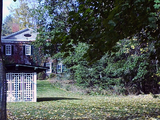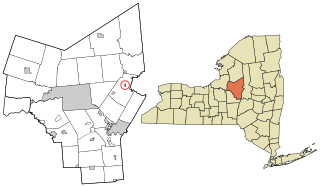
Barneveld is a hamlet located within the Town of Trenton in Oneida County, New York, United States. The population was 284 at the 2010 census, when it was an incorporated village. The name is derived from the name of the Dutch statesman Johan van Oldenbarnevelt (1547–1619).

Buffalo City Hall is the seat for municipal government in the City of Buffalo, New York. Located at 65 Niagara Square, the 32-story Art Deco building was completed in 1931 by Dietel, Wade & Jones.

The New York State Capitol, the seat of the New York state government, is located in Albany, the capital city of the U.S. state of New York. The capitol building is part of the Empire State Plaza complex on State Street in Capitol Park. Housing the New York State Legislature, the building was completed in 1899 at a cost of US$25 million, making it the most expensive government building of its time. It was listed on the National Register of Historic Places in 1971, then included as a contributing property when the Lafayette Park Historic District was listed in 1978. The New York State Capitol was declared a National Historic Landmark in 1979.

List of the National Register of Historic Places listings in Essex County, New York.
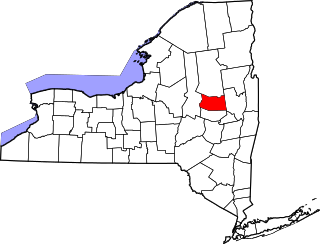
List of the National Register of Historic Places listings in Fulton County, New York
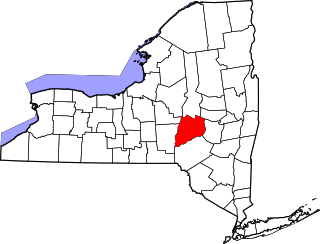
List of the National Register of Historic Places listings in Otsego County, New York

List of the National Register of Historic Places listings in Tompkins County, New York

The Chester A. Arthur Home was the residence of the 21st president of the United States, Chester A. Arthur (1829–1886), both before and after his four years in Washington, D.C., while serving as vice president and then as president. It is located at 123 Lexington Avenue, between 28th and 29th Streets in Rose Hill, Manhattan, New York City. Arthur spent most of his adult life living in the residence. While Vice President, Arthur retreated to the house after the July 2, 1881 shooting of President James Garfield. Arthur was in residence here when Garfield died on September 19, and took the presidential oath of office in the building. A commemorative bronze plaque was placed inside the building in 1964 by the Native New Yorkers Historical Society and New York Life Insurance, and the house was designated a National Historic Landmark on January 12, 1965.
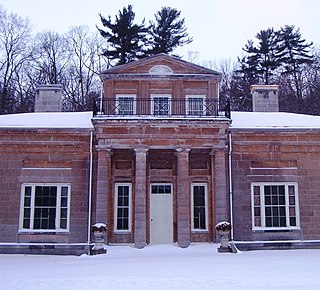
Hyde Hall is a neoclassical country mansion in Springfield Center, New York, designed by architect Philip Hooker for George Clarke (1768–1835), a wealthy landowner. The house was constructed between 1817 and 1834, and designed with English and American architectural features. It was designated a National Historic Landmark in 1986 for its architecture, and the completeness of its architectural documentary record. It is one of the few surviving works of Philip Hooker, a leading 19th-century American architect.
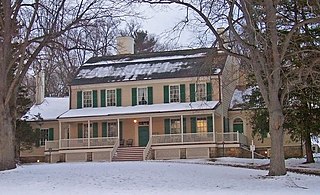
The John Jay Homestead State Historic Site is located at 400 Jay Street in Katonah, New York. The site preserves the 1787 home of Founding Father and statesman John Jay (1745–1829), one of the three authors of The Federalist Papers and the first Chief Justice of the United States. The property was designated a National Historic Landmark in 1981 for its association with Jay. The house is open year-round for tours.

Adam Gerard Mappa was a Dutch type-founder, Patriot and active colonel in a local militia. In 1794 he became the agent for the Holland Land Company in New York (state) and three years later supervisor in the recently set up village of Barneveld.
Leland Castle is a building in New Rochelle, New York. It was constructed during the years in 1855 - 1859 in the Gothic Revival style, and was the country residence of Simeon Leland, a wealthy New York City hotel proprietor. Leland began to assemble an estate as early as 1848, and in 1855, began the erection of this palatial 60-room mansion. The home was designed by New York City architect William Thomas Beers. A north and south wing were added to the castle in 1899 and 1902 respectively.

Wildcliff, also referred to as the Cyrus Lawton House, was a historic residence overlooking Long Island Sound in New Rochelle in Westchester County, New York. This 20-room cottage-villa, built in about 1852, was designed by prominent architect Alexander Jackson Davis in the Gothic Revival style. The home was added to the National Register of Historic Places on December 31, 2002.

There are 75 properties listed on the National Register of Historic Places in Albany, New York, United States. Six are additionally designated as National Historic Landmarks (NHLs), the most of any city in the state after New York City. Another 14 are historic districts, for which 20 of the listings are also contributing properties. Two properties, both buildings, that had been listed in the past but have since been demolished have been delisted; one building that is also no longer extant remains listed.

N. Velzer House and Caretaker's Cottage is a historic home and cottage located at Centerport in Suffolk County, New York. The house is a 2+1⁄2-story, three-bay clapboard structure flanked by 1+1⁄2-story, two-bay, gable-roofed wings. It was built about 1830 and exhibits restrained Greek Revival details. The cottage is a 2+1⁄2-story, clapboard residence with a shallow gable roof and a three-bay, side-hall plan.

The Davenport House, also known as Sans-Souci, is an 1859 residence in New Rochelle, New York, designed by architect Alexander Jackson Davis in the Gothic Revival style. The "architecturally significant cottage and its compatible architect-designed additions represent a rare assemblage of mid-19th through early 20th century American residential design". The house was listed on the National Register of Historic Places in 1980.

Rock Hall is a historic home located at Lawrence in Nassau County, New York. It was built about 1767 and stands on a manorial, park-like setting overlooking Jamaica Bay. It is a 2+1⁄2-story, Georgian-style frame dwelling, with a T-shaped frame wing. It is five bays wide, with a central portico shielding the main entry. During the early 1950s the town of Hempstead restored Rock Hall to its 18th-century appearance.

Seaview Hospital is a historic hospital complex in Willowbrook on Staten Island, New York. The original complex was planned and built between 1905 and 1938 and was the largest and most costly municipal facility for the treatment of tuberculosis of its date in the United States. After being shuttered, the complex was listed as a national historic district.

Brooks and Hewitt Halls are historic dormitory buildings located on the campus of Barnard College in Morningside Heights, New York, New York. Brooks Hall was designed by Charles A. Rich (1854–1943) and built in 1906–1907. It is a seven and one half story, red Harvard brick building on a granite foundation with limestone and terra cotta trim. It features a sloping Spanish tile roof with hip-roof dormer windows. Hewitt Hall, named for Abram S. Hewitt, was designed by McKim, Mead & White and built in 1926–1927. It is a seven-story, red Harvard brick building with a sloping copper clad roof.
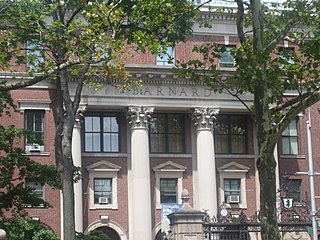
Barnard Hall, originally known as Student's Hall, is a historic educational building located on the campus of Barnard College in Morningside Heights, New York, New York. It was designed by Arnold W. Brunner and Buchman & Fox in 1916, and contains classrooms. It is four stories on a raised basement built of dark red brick with white limestone and terra cotta details. It combines Italian Renaissance massing and detail with Colonial Revival inspired features. The front facade features a three-story limestone portico with four monumental Corinthian order columns.




